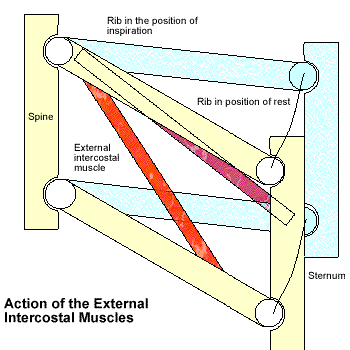The Action of the External Intercostals
The External Intercostals, like all muscles, work by contracting and getting shorter. Though there is some debate around exactly how the intercostals work, the principle is pretty simple. It is important that we think of the ribs like a door controlled by a spring (which is standing in for the muscle). The ribs hinge at the spine . They also hinge at the sternum, if you're being really exact, but what is most important, so far, is to image this mechanical model.

The image above gives you a visual to go along with the model we will be discussing. The portions of the image which are blue represent where the ribs and sternum get to on an inhalation. The ribs at rest are in yellow. On the left of the image is the spine, which serves as the door frame. The orangy strip represents an external intercostal muscle fiber connecting two ribs. As the muscle contracts (the purplish strip) and shortens, it lifts the rib to the blue position. By raising the ribs, the external intercostal muscles increase lung volume, making a negative pressure difference. If the throat is open, air will rush into the lungs.
In other words, the extrinsic muscles help with inhalation.
Now, let's see what the intrinsic muscles do...
- The Action of the External Intercostal Muscles
- The Action of The Internal Intercostal Muscles
Back to the Intercostals
Back to Respiration
- More on Anatomy
- The Physics of Breathing
- Application to the Performer

